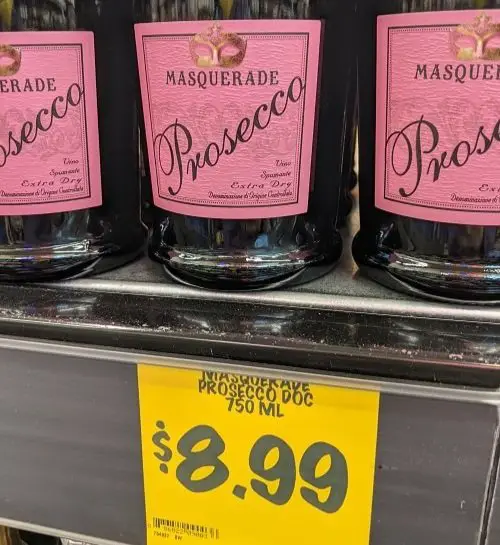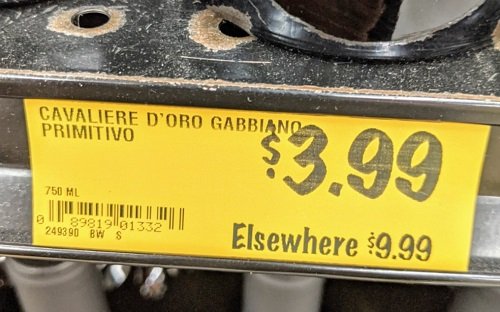
How Grocery Outlet Wine Works
Not all of you have had the adrenaline-inducing shopping experience that is Grocery Outlet. Today I’m stepping through their sliding glass doors into a slightly chaotic world where savvy shoppers flex their bargain-hunting skills.
Grocery Outlet is able to carry discount wine and offer it at cheap prices thanks to their unique business model. The store can source close-out lots from wineries and offer it to their shoppers at a deep discount. The store relies on volume, not price for its profit margin.
Principally a West Coast grocery chain, their business model functions by purchasing odd lots and surplus goods at a deep discount, then passing those savings onto consumers.
And who doesn’t love a bargain?
The typical Grocery Outlet shopping cart could include gourmet biscotti, name brand sports nutrition bars, organic high-end facial cleanser, and your standard milk and eggs.
Our family can walk out of Grocery Outlet with a cart full of food for ½ the price of the more mainstream chains, and easily ¼ the price of Whole Foods.
A simple sell for budget-minded households.
How Does the Grocery Outlet Wine Department work?

But let’s look at the wine department, where Grocery Outlet employs the same surplus purchasing strategies for its vino, which leads to smoking deals for wine lovers – if you know what you’re looking for.
To better understand how a wine finds its way to a local Grocery Outlet shelf, we need to look at the larger wine production process.
Where Does Grocery Outlet Wine Come From?

Every year, wineries forecast how much wine they’ll need to satisfy demand. Wineries may plan on selling an impressive 50,000 cases, or a more modest 3,000 cases.
Wine, as we know, is a physical product that takes up floor space. It needs a place to call ‘home’ until sold. A palate holds 75 cases: 3,000 cases = 40 palates.
That’s a footprint!
While some extremely large or teeny tiny producers may store their wines in their own cellars, most wineries fall somewhere in the middle and keep their inventory at off-premise warehouses for centralized distribution.
If the winery cannot sell all of its inventory before it needs space for the next harvest (either its own or rented space), it has to find a way to move that excess inventory.
Oh, to have such problems!
Let’s say the winery that makes 50,000 cases per year only sells 49,000 cases; it has an extra 1,000 cases, or 12,000 bottles to off-load.
A small, 3,000 case producer may sell 2,700 cases and still have 300 cases, or 3,600 bottles on hand.
Enter Grocery Outlet.
Wineries approach Grocery Outlet with their excess inventory and the company bulk purchases the wine at a deep discount – maybe just a little above production costs.
This wine physically moves to a centralized Grocery Outlet warehouse where it’s stored as inventory.
The Grocery Outlet retailers, which are independently owned and operated, order wine from this central warehouse depending on the local customers’ tastes and drinking habits.
The wine arrives at the neighborhood store where it moves quickly thanks to deep discounts.

Here’s a price tag for a Cabernet Sauvignon wine. The original price was $14.95, discounted to $4.99. Depending on where the producer sourced the grapes, this bottle likely cost around $3.50-$4.80 to make. Harsh economics.
Helpful Tip: Into economics? Check out this comprehensive post on how producers and wine shops come up with the price you see on a bottle of wine. It’s not as simple as you might think.
What does high sales volume mean for wine lovers?
First, you’re lured to the store with the possibility of new discoveries arriving regularly. The stores rarely advertise individual wines and prices in their weekly circulars, a deliberate marketing choice that’s part of the chain’s agreement with the wineries.
The wineries are rightfully concerned about promoting their labels as discounted brands.
This physical barrier to knowing what’s on sale before setting foot in the store means that you’re compelled to visit and see what new treasures have turned up.
Discover something wonderful? Boom! Dopamine hit.
Will a Good Wine You Find at Grocery Outlet Be There Next Time?
The second takeaway from the Grocery Outlet model is that inventory will be limited. You don’t know how many cases of a particular wine the store ordered, and you don’t know how many cases of that wine are back at the wine warehouse.
This limited supply creates a sense of urgency for the buyer.
Rarely will you find that unique gem of a wine from last month still on the shelves.
If you do happen to find a delightful bottle that’s been discounted from, say, $18 USD down to $4 USD, the savvy connoisseur would hightail it back like it’s 5:00 am on Black Friday to scoop up a case or two.
Go! Now! Why are you still reading this post?!?
In fact, one of my early first-hand experiences with Grocery Outlet wine was just this kind of scenario.
I had recently moved to the area as a wine neophyte lo those many years ago. A gentleman was emptying an entire shelf of a Mission Trail label into his cart.
I naively asked him if the wine was any good. His reply? “It’s Mission Trail.” (Note: Mission Trail is a local boutique winery). I purchased a bottle that more than lived up to the wise words of my fellow shopper.
Imagine my disappointment when I returned a week later to find the store had sold out.
Which brings us to the third strategy Grocery Outlet leverages to move wine.
Why Kinds of Wine Does Grocery Outlet Have?
Your store will probably focus on regional labels and wines that carry some name recognition with the local clientele.
Look for the good stuff – small regional labels that command the majority of the store’s shelf space.
By catering to known production regions and local-ish producers, the store targets enthusiasts who know their wines and are willing to spend liberally on bargain bottles.
Bottles from major bulk wine producers normally found in your standard chain grocery store have no place in the Grocery Outlet business proposition (e.g, Yellow Tail, Meomi, Barefoot).
Helpful Tip: Here’s a separate post with 11 easy strategies on how to buy wine at a grocery store.
Can You Find Import Wines at Grocery Outlet?
Yes, you can find wines from different countries at Grocery Outlet, including your French sparkling wine and your staple Italian Chianti, but they’ll be lower-end, bulk wines.

Check out this Italian wine: Cavaliere d’Oro Gabbiano Primitivo. Primitivo is the Italian name for Zinfandel. This Primitivo comes from Puglia, the boot heel region of Italy known for bulk wine production.

Here’s another import label. This Aussie import Luck Duck Shiraz wine is from South Eastern Australia.
South Eastern Australia covers most of the southeastern part of the country and is known for bulk wine production thanks to fertile soils, warm weather, and extensive irrigation.
It’s amazing that you can find an imported wine at a regular price of $3.99 and a discount price of $1.99 – inclusive of shipping costs and import duties.
I won’t even try to guess what the production costs were for this bottle, but the most expensive thing going for it is probably the glass.
Is Grocery Outlet Wine Any Good?
Grocery Outlet offers good, solid-quality wines that are a great place for new wine lovers and savvy bargain hunters alike.
This, my friend, is an easy entrée into the world of wine. Take the time to read labels. Yes, you may feel a little self-conscious scrutinizing discount wine, but spend the time and you’ll find awesome wines.
You’ll find small production treasures from boutique wineries tucked away on the shelves. These price points make Taco Tuesday paired with a full-bodied, old vine Zin a no-brainer.
Thirsty for More: Are you a frugal wine lover?
Check out
13 ways to enjoy wine for less money
How Do You Host a Blind Wine Tasting at Home?
8 Things You Must Know Before Going Wine Tasting for the First Time
How to Start a Wine Tasting Group



